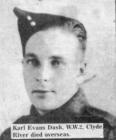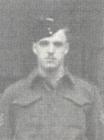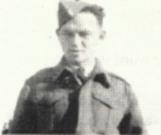28
Dash, Karl Evans. F78389. Sapper. 1 Field Squadron. Royal Canadian Engineers.Karl Dash was a labourer when he enlisted 7 May in Halifax. He trained as a sapper in Pettawawa, Ontario and qualified as a steamfitter "B" on 7 October 1941. He embarked from Halifax on 19 March 1942. On 24 September 1942 he graduated from a Fire Fighting Course and it was noted he was capable to instruct. He embarked for France on 20 March 1945. He was "a good motor cycle rider with plenty of experience" when he was struck at 0145 hours by a civilian vehicle. His injuries included a fracture at the base of the skull, fracture of 4th and 5th ribs and of the chest wall. He was brought to the #6 Canadian General Hospital and died shortly after. Buried at Holten Canadian War Cemetery. Grave 10, Row B, Plot 5, Overijessel, Netherlands.
30
Doane, Elmer. Lieutenant. West Nova Scotia Regiment. Royal Canadian Infantry Corps.1919 to 1943.
Elmer Doane served in the United States Home Guard before joining the Canadian Army at New Glasgow, Nova Scotia on 1 February 1942. He was promoted immediately to acting sergeant and then to sergeant instructor on 1 April 1942. Elmer was soon posted to Brockville, ON and promoted to Second Lieutenant on 9 May 1942 and to Lieutenant on 12 June 1942. Embarked for overseas 9 March 1943.
Thomas Raddall. West Novas. A history of the West Nova Regiment describes the push to control Mount Criscanna on 2 August 1943. Elmer, who was in charge of "A" company's mortars "exposed himself repeatedly in his efforts to get his weapons to bear on the German defences". [pp103, 158]. Four months later on 12 December 1943, in the Battle for Ortona the German fighting patrols "had been creeping out of the gully to feel out the West Novas positions". In an attempt to drive off the German patrols Elmer was struck by a shell and died instantly.
32
Williams, Harvey Francis F56778. Private. North Nova Scotia Highlanders. Royal Canadian Infantry Corps. 1923 to 1944.Harvey Williams was an inshore fisherman when he enlisted 26 April 1943. He embarked for overseas in April 1944 and was "in the field" in France on 6 June 1944. The North Novas suffered heavy casualties at Boulogne during their capture of the Mount Lambert Fortress. Harvey was one of the casualties. Buried at Calais Canadian War Cemetery, Grave 7, Row C , Plot 2, Leubringhen, Pas de Calais, France.
34
Turpin, Francis Edward.F96109. Private. West Nova Scotia Regiment. 1923 to 1944.Frank Turpin was a carpenter's helper when he enlisted in Yarmouth on 9 December 1941. He arrived with the regiment in Sicily in July 1943 and was wounded on 30 July 1943 in the left thigh. He was in the hospital until 28 August 1943 when he was discharged as fit to return to action. He was killed on 14 December 1944 when the regiment was clearing the appoaches to Ortona. Buried in Moro River Cemetery, Grave 11, Row A , Plot 5.
36
Schoultz, Roger Byron. Corporal. Royal Canadian Regiment.Schoultz, Roger Byron. Born 1929 in Shelburne; killed in action in Korea on 3 May 1953. Son of John Alfred and Genesta Pearl (Nickerson) Schoultz. He had two brothers, Herman and Russell. Roger was the only Shelburne County casualty of the Korean War.
38
MacKenzie, George Harold F40247. Private. West Nova Scotia Regiment. 1911 to 1943.George MacKenzie embarked for England aboard the Polish liner Chorby on 22 December 1939 and arrived 30 December 1939 at Gourock, Scotland. The regiment then proceeded by train to Guillemont Barracks, near Aldershot, England. They trained in England and later moved to Scotland for training in the highlands. The regiment sailed on 16 June 1943 aboard the Polish liner Batory for Sicily and waded ashore on 10 July 1943.






